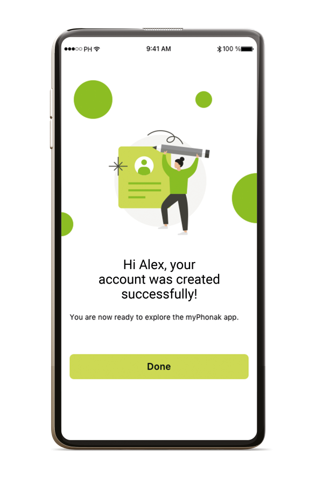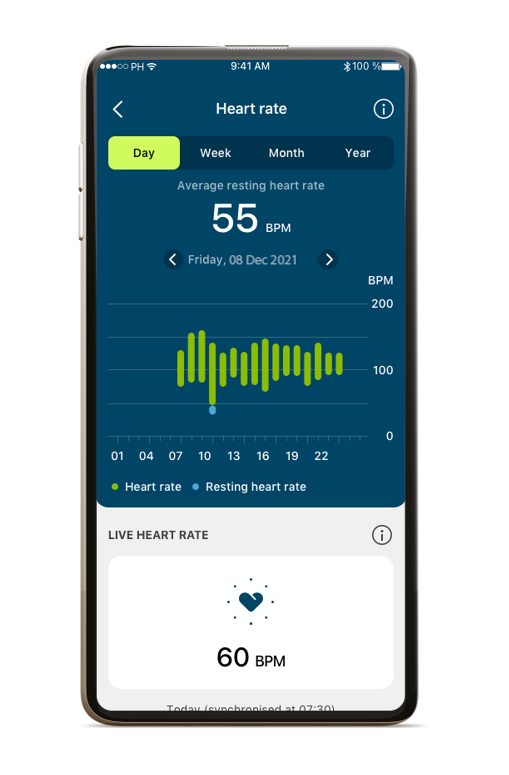Question
How does the new receiver used with Phonak Audéo Fit™ work, and what can a user expect to see in the new myPhonak app?
Answer
Audéo Fit comes with two brand new receiver options: either a Sensor Receiver or a Sensor cShell. They are hybrids between the receiver-in-the-canal technology consumer wearable devices, so they can deliver sound to a patient’s ear and measure health information like heart rate.
For the sound reproduction provided by the receiver, the Sensor Receiver is a M receiver and the Sensor cShell is available as either an M or P receiver. Combined, these receivers have fitting ranges covering a wide range of degree and configuration of hearing loss from mild to severe. Regardless of the power level, the receivers have been combined with something like a pulse oximeter and uses light beams to estimate the heart rate. This method used to track the heart rate is called photoplethysmography (PPG).
How PPG uses LEDs to track heart rate
PPG is based on a very simple fact that blood absorbs light and that the amount of light absorbed or reflected rhythmically changes during an individual’s pulse train. The Sensor Receiver is sending out light using “Light Emitting Diodes” or LEDs. During the pulse train, more light from the LEDs is absorbed and less light reflected during a peak of the pulse. During a trough, it's the opposite; less light is absorbed and the reflection is higher. The photosensor is able to detect the changes of the intensity of the reflected light and allows the device to extract the pulse rate using sophisticated signal processing.
Coupling options available for the Sensor Receiver
The acoustic coupling available for patients include a customized cShell or a Fit & Go solution using domes. The Sensor Receiver must be used in combination with either a SDS 4.0 Cap or Open dome or the new Vented Clear dome. SDS 4.0 vented or power domes will impact Audéo Fit functionality by occluding the light sensors. Because the LEDs are sending out light and the photodetector is detecting the different levels of reflected light, these domes cannot be used. The reason for this is to minimize an unwanted sunlight influence or a cross-talk between the LEDs and the Photosensor.
If a custom acoustic coupling is preferred or a stronger receiver is needed, the Sensor cShell is the best option. It delivers the same functionalities and can be equipped with a M or P receiver that have the same fitting range as what is available with Audéo Paradise today. The acrylic material chosen to make the cShell prevents light transmission through the shell to reduce a cross-talk between LED and Photodetector but also to reduce sunlight effects. For this reason, transparent cShell and faceplate options are not available with the Audéo Fit.
Receiver options that can be used with Audéo Fit
The new Sensor Receiver uses an 8-Pin connection to handle both the information from the hearing aid and the sensors. Attaching or removing the receiver does not require additional tools. Simply plug it into the hearing aid where it locks into place or grab the receiver close to the hearing aid and gently pull the receiver to remove it. While it is easy to use, other 3-pin receivers are not compatible with Audéo Fit. Since the receiver attachment is different, it bears mentioning that the hearing aid itself comes in a size that's comparable to Audéo Paradise RT, and in the three most popular color options: sand beige, chestnut and silver grey.
How a patient sees their health information in the myPhonak app
The myPhonak has undergone many significant updates in design that make the features easier to access, understand and use in day-to-day activities. On top of these designs to deepen engagement in hearing better, the health section of the app provides an opportunity to engage in details that can encourage healthy living.
To begin seeing health details offered by the Audéo Fit hearing aids, patients will need to create a myPhonak account or log in using their existing myPhonak account details to view their health data. By registering and logging in, we can ensure all their collected health data is safe and can only be accessed by them. All a patient needs to enter to create an account is their email address, a password, and the country they live in.

Heart Rate
Using the information of the heart rate sensor, the following options can be displayed with the myPhonak app:
- On-demand (live) heart rate, which will be calculated every four seconds
- A temporal overview of the heart rate on a daily, weekly, monthly and yearly basis
- Resting heart rate
In this picture, Audéo Fit and the myPhonak app track and display the resting heart rate, which will be calculated after the hearing aids have been worn for a minimum of four hours. Each person's heart rate is unique.

Steps
Thanks to the motion sensor in Audéo Fit, patients can also track their physical activities without additional devices. The motion sensor is now able to count the total number of detected steps based on the accelerometer signal. Audéo Fit can compute the distance walked or ran and since mobile health interventions may facilitate engagement in healthful behaviors1,2, the resulting insights and self-awareness could empower them to make proactive lifestyle changes to improve their health. Additionally, Audéo Fit and the myPhonak app automatically track and display the time the patient engages in various levels of activities, such as light activity, walking, running or being sedentary. Patients are given the option to set goals for increasing their physical activity.

Wearing Time
Finally, patients are also able to track their hearing aid wearing time and view the wearing time in different acoustic environments, which can help to acclimatize in different listening situations. Goals can also be set to reach a desired wearing time.
To simplify the classification of the acoustic environment for the patient we have grouped the AutoSense OS 4.0 programs into four categories:
- Calm situations
- Noisy situations (Target programs: Speech in Noise, Speech in loud noise, Speech in Car, Comfort in Echo and Comfort in Noise)
- Music
- Streaming

These new features available in Audéo Fit expand the experience of hearing well into new opportunities to promote well-being. Our aim is that the role of hearing care professionals and the conversations you are having with patients will gradually change over time so that individuals with hearing loss can make the most out their technology and continue to thrive. The best way to learn the technology is to try it out for yourself and begin discussing it with patients. If you have any further questions, please don’t hesitate to reach out to us and schedule a visit with a sales rep or clinical trainer.
For more information on Phonak Audéo Fit and the myPhonak app, click here.
References:
- Buyl, R., Beogo, I., Fobelets, M., Deletroz, C., van Landuyt, P., Dequanter, S., Gorus, E., Bourbonnais, A., Bourbonnais, A., Giguère, A., Giguère, A., Giguère, A., Lechasseur, K., Gagnon, M. P., Gagnon, M. P., & Gagnon, M. P. (2020). E-Health interventions for healthy aging: A systematic review. Systematic Reviews, 9(1), 1–16. https://doi.org/10.1186/s13643-020-01385-8
- Marcolino, M. S., Oliveira, J. A. Q., D’Agostino, M., Ribeiro, A. L., Alkmim, M. B. M., & Novillo-Ortiz, D. (2018). The impact of mHealth interventions: Systematic review of systematic reviews. JMIR MHealth and UHealth, 6(1). https://doi.org/10.2196/mhealth.8873

